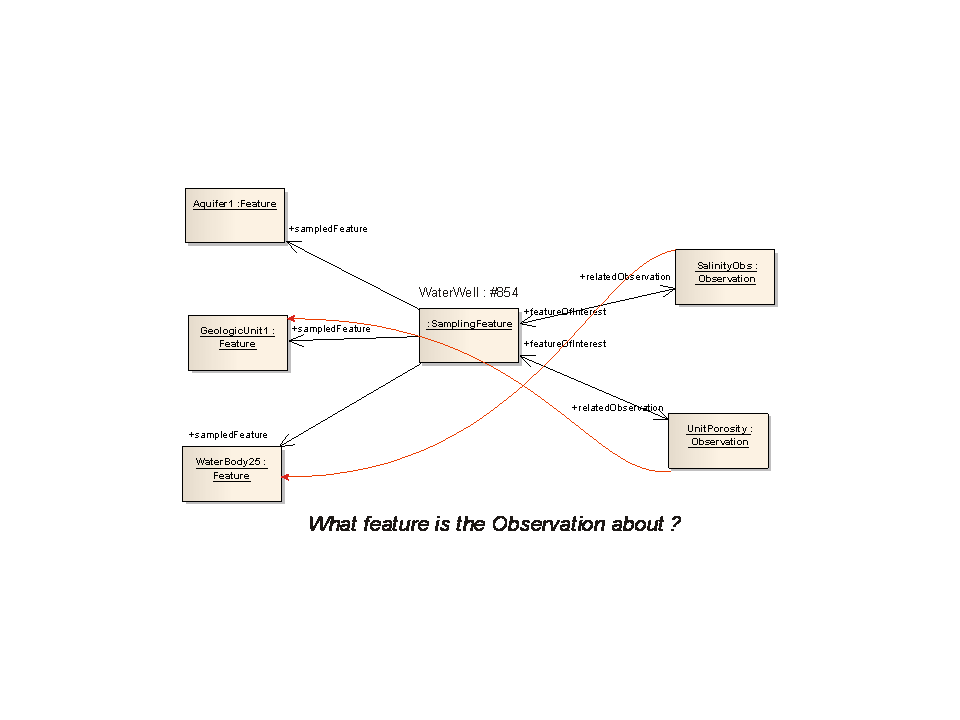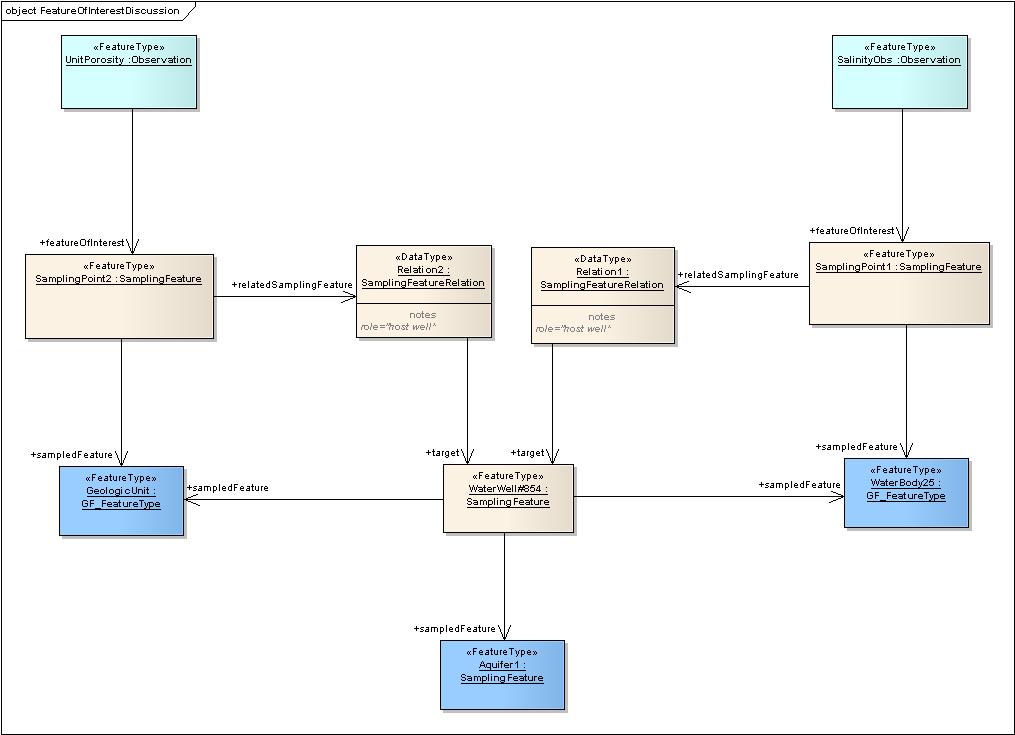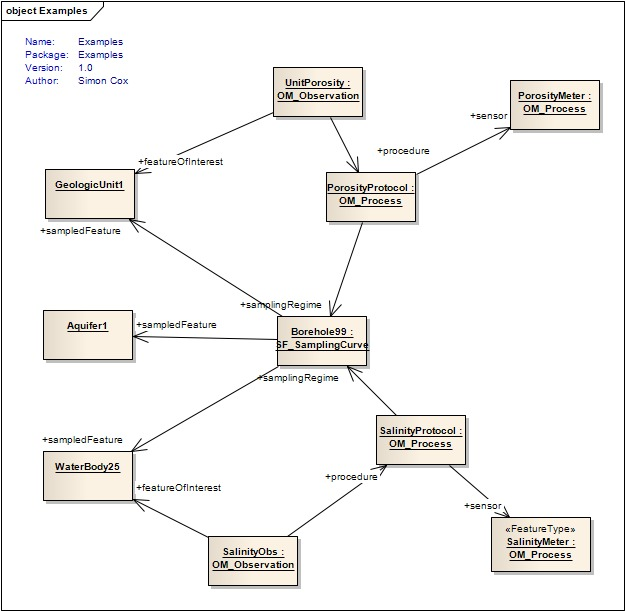You are here: OGC Public Wiki>HydrologyDWG Web>GroundwaterInteroperabilityExperiment>SamplingFeature (05 Sep 2013, KevinStegemoller)Edit Attach
SamplingFeature Discussion
What should be the featureOfInterest of an Observation
There was a lot of discussion around the featureOfInterest (foi) of an Observation. The foi of an Observation is any feature, which obviously includes any SamplingFeature. There are several arguments for and against using SamplingFeature, but it's beyond the point for this small note. I just realised that there is a gotcha in using either options (foi is the real feature and foi is a SamplingFeature). Let's consider this example. We have a Water well that "samples" 3 features: It samples the Aquifer, it also samples the Geologic unit, and it also samples the WaterBody (Note we can argue that aquifer and water body are the same thing, but it's not important for this example). At this well (which is a sampling feature), we have 2 Observation. One for Salinity and the other for Porosity. Obviously, salinity is a property of the water and porosity is a property of GeologicUnit (red lines on the first figure). Now, if we try to encode all this into O&M and Sampling, we have 2 options First, use the Well as a foi (foi is a SamplingFeature). The way to traverse from Observation to feature we are observing is to traverse from Observation/featureOfInterest/SamplingFeature/sampledFeature/Feature- foi is a sampling feature:

 In this case, I can't traverse from the observation to the SamplingFeature at all. sampledFeature is unidirectional (bidirectional links are enemy of interoperability, dixit Simon Cox)
There seems to be no way to connect those entities for a complete story.
Maybe linking the Observation to both SamplingFeature and the real feature ?
Am I missing anything ?
-- EricBoisvert - 15 Jan 2010
Ok see what you mean; not sure I have the exact answer to this but see what comes out.
The first approach is the most appropriate from what I can tell, but as you say the problem is the existence of two sampledFeatures. I think what we need to separate out is the intent of each observation. The observed property of the observation must be a property of the domain feature, so if you split these into two observations and use the samplingFeatureRelation to describe the 'real world' relationships of the three way aquifer-waterbody-geologic unit relationship it might work. Here is an attempt:
In this case, I can't traverse from the observation to the SamplingFeature at all. sampledFeature is unidirectional (bidirectional links are enemy of interoperability, dixit Simon Cox)
There seems to be no way to connect those entities for a complete story.
Maybe linking the Observation to both SamplingFeature and the real feature ?
Am I missing anything ?
-- EricBoisvert - 15 Jan 2010
Ok see what you mean; not sure I have the exact answer to this but see what comes out.
The first approach is the most appropriate from what I can tell, but as you say the problem is the existence of two sampledFeatures. I think what we need to separate out is the intent of each observation. The observed property of the observation must be a property of the domain feature, so if you split these into two observations and use the samplingFeatureRelation to describe the 'real world' relationships of the three way aquifer-waterbody-geologic unit relationship it might work. Here is an attempt:
 I've created the sampling points as the measuring locations within the well, depending on the measurement process they could be more complex geometries. These sampling features contain the intent of each observation. The samplingFeatureRelation role describes the nature of the relationship. I have host well here but there may be something else may be more appropriate.
This allows the observation to be understood in context and the more complex feature relations to exist and be traversed, but the relations hold the semantics of how the real world features relate - not sure if this too much of a hidden contract in the design?
-- PeterTaylor - 04 Feb 2010
"The observed property of the observation must be a property of the domain feature".
I always had a problem with this rule. It essentially prevent observation to be made on features outside a given domain, unless you are lucky. Actually, this rule contradicts Simon rules (funny, I believe they are both from him) that bidirectional links are enemies of interoperabily. Having a rule that forces a property to exist in a feature to make an observation is just the same kind of contraint than having an explicit link from that feature to a domain specific Observation. This rule would actually prevent an GWML observation on permeability of a Rock because GeoSciML did not implement this property. I don't think it's right.
What you are proposing is to create sub sampling features for each observation. I think it's a lot of mechanic and it adds to user headaches to query that thing. Actually, wouldn't be easier to add a property to Observation (or subtype Observation) so it has both featureOfInterest (the real feature) and relatedSamplingFeature
I've created the sampling points as the measuring locations within the well, depending on the measurement process they could be more complex geometries. These sampling features contain the intent of each observation. The samplingFeatureRelation role describes the nature of the relationship. I have host well here but there may be something else may be more appropriate.
This allows the observation to be understood in context and the more complex feature relations to exist and be traversed, but the relations hold the semantics of how the real world features relate - not sure if this too much of a hidden contract in the design?
-- PeterTaylor - 04 Feb 2010
"The observed property of the observation must be a property of the domain feature".
I always had a problem with this rule. It essentially prevent observation to be made on features outside a given domain, unless you are lucky. Actually, this rule contradicts Simon rules (funny, I believe they are both from him) that bidirectional links are enemies of interoperabily. Having a rule that forces a property to exist in a feature to make an observation is just the same kind of contraint than having an explicit link from that feature to a domain specific Observation. This rule would actually prevent an GWML observation on permeability of a Rock because GeoSciML did not implement this property. I don't think it's right.
What you are proposing is to create sub sampling features for each observation. I think it's a lot of mechanic and it adds to user headaches to query that thing. Actually, wouldn't be easier to add a property to Observation (or subtype Observation) so it has both featureOfInterest (the real feature) and relatedSamplingFeature
- Observation that has no feature of interest means that we don't know yet (or will never know) what is the foi
- Observation that has no related sampling feature are "casual" observations
- SamplingFeatures keep their birectional link with Observation, so you can traverse SamplingFeature to featureOfInterest
- Sampling Feature is part of the observation protocol:

- traverse from Observation to the SamplingFeature with Observation/procedure/OM_Process/samplingRegime/SamplingFeature
- traverse from SamplingFeature to Observation using relatedObservation (I added them on your diagram)
- traverse from SamplingFeature to the real feature with SamplingFeature /relatedObservation/Observation/featureOfInterest/Feature or SamplingFeature /sampledFeature/Feature. The "real feature" from either path could be different, most probably, the observation path would lead to a part of the feature pointed by sampledFeature.
- O&M full story:

| I | Attachment | Action | Size | Date | Who | Comment |
|---|---|---|---|---|---|---|
| |
FeatureOfInterestDiscussion.jpg | manage | 62 K | 04 Feb 2010 - 06:38 | PeterTaylor | using sampling feature relations |
| |
SamplingFeatureExample.png | manage | 142 K | 05 Sep 2013 - 15:12 | KevinStegemoller | Sampling Feature is part of the observation protocol |
| |
foif.png | manage | 23 K | 15 Jan 2010 - 10:46 | EricBoisvert | foi is a feature |
| |
fois.png | manage | 8 K | 15 Jan 2010 - 10:46 | EricBoisvert | foi is a sampling feature |
| |
om_sf_2.png | manage | 38 K | 08 Feb 2010 - 13:19 | EricBoisvert | O&M full story |
Edit | Attach | Print version | History: r10 < r9 < r8 < r7 | Backlinks | View wiki text | Edit wiki text | More topic actions
Topic revision: r10 - 05 Sep 2013, KevinStegemoller
- Webs
-
 AIP8
AIP8
-
 ASTROdwg
ASTROdwg
-
 AgricultureSummit
AgricultureSummit
-
 AustraliaNewZealandForum
AustraliaNewZealandForum
-
 AviationDWG
AviationDWG
-
 BigDataDwg
BigDataDwg
-
 BusinessValueCommittee
BusinessValueCommittee
-
 CATdiscuss
CATdiscuss
-
 CDBswg
CDBswg
-
 CRSdefinitionResolver
CRSdefinitionResolver
-
 CRSdwg
CRSdwg
-
 CanadaForum
CanadaForum
-
 ChinaForum
ChinaForum
-
 CitSciIE
CitSciIE
-
 CitizenScienceDWG
CitizenScienceDWG
-
 ClimateChallenge2009
ClimateChallenge2009
-
 CoveragesDWG
CoveragesDWG
-
 DiscreteGlobalGridSystemsDWG
DiscreteGlobalGridSystemsDWG
-
 EMSpectrumDWG
EMSpectrumDWG
-
 EMspectrumDWG
EMspectrumDWG
-
 ERGuidance
ERGuidance
-
 EUforum
EUforum
-
 EarthCube
EarthCube
-
 EnergyUtilitiesDwg
EnergyUtilitiesDwg
-
 GML
GML
-
 GeoSciMLswg
GeoSciMLswg
-
 GeoScienceDWG
GeoScienceDWG
-
 GeocodingAdHoc
GeocodingAdHoc
-
 Geospatial3DMS
Geospatial3DMS
-
 HealthDWG
HealthDWG
-
 HydrologyDWG
HydrologyDWG
-
 I15swg
I15swg
-
 ILAFpublic
ILAFpublic
-
 ISGdwg
ISGdwg
-
 Ideas4OGC
Ideas4OGC
-
 JAG
JAG
-
 JSONsubGroup
JSONsubGroup
-
 JapanAssistance
JapanAssistance
-
 LandAdminDWG
LandAdminDWG
-
 MLSdwg
MLSdwg
-
 Main
Main
-
 MarineDWG
MarineDWG
-
 MassMarket
MassMarket
-
 MetOceanDWG
MetOceanDWG
-
 NREwg
NREwg
-
 NetCDFu
NetCDFu
-
 NordicForum
NordicForum
-
 OGC
OGC
-
 PointCloudDWG
PointCloudDWG
-
 QualityOfService
QualityOfService
-
 SWEProCitSci
SWEProCitSci
-
 Sandbox
Sandbox
-
 SmartCitiesDWG
SmartCitiesDWG
-
 System
System
-
 TemporalDWG
TemporalDWG
-
 UKIAP2013
UKIAP2013
-
 UrbanPlanningDWG
UrbanPlanningDWG
-
 Vocabulary
Vocabulary
-
 WCTileServiceSWG
WCTileServiceSWG
-
 WPS
WPS
-
 WaterML
WaterML
 The information you supply is used for OGC purposes only. We will never pass your contact details to any third party without your prior consent.
The information you supply is used for OGC purposes only. We will never pass your contact details to any third party without your prior consent. If you enter content here you are agreeing to the OGC privacy policy.
Copyright &© by the contributing authors. All material on this collaboration platform is the property of the contributing authors.
Ideas, requests, problems regarding OGC Public Wiki? Send feedback


